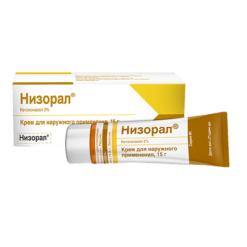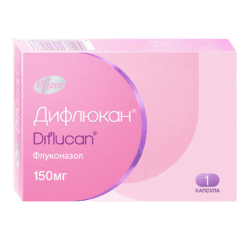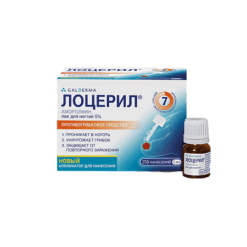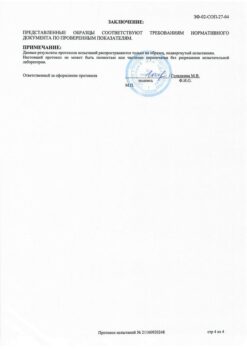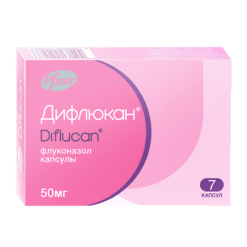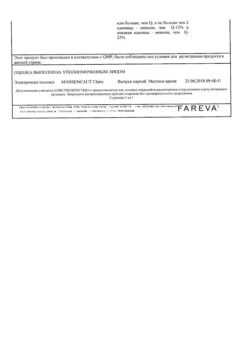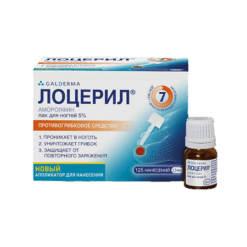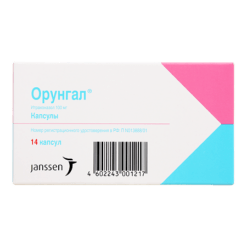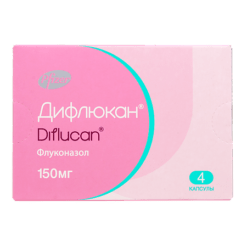No products in the cart.
Orungamin, 100 mg capsules 14 pcs
€26.12 €23.04
Description
Itraconazole is a synthetic broad-spectrum antifungal agent, a triazole derivative. It inhibits ergosterol synthesis of the cell membrane of fungi, which determines the antifungal effect of the drug.
Itraconazole is active against:
- dermatophytes (Trichophyton spp, Microsporum spp, Epidermophyton floccosum),
- dermatophyte fungi Candida spp. (including Candida albicans, Candida parapsilosis),
- Mould fungi (Cryptococcus neoformans, Aspergillus spp, Trichosporon spp., Geotrichum spp., Penicillium mameffei, Pseudallescheria boydii, Histoplasma spp., Coccidioides immitis, Paracoccidioides braziliensis, Sporothrix schenckii. Fonsecaea spp., Cladosporium spp., Blastomyces dermatidis), Malassezia spp..
Some strains may be resistant to itraconazole: C. glabrata, C. krusei, C. tropicalis, Absidia spp, Fusarium spp., Mucor spp., Rhizomucor spp. Rhizopus spp., Scedosporium proliferans, Scopulariopsis spp. The efficacy of treatment was evaluated in 2-4 weeks after cessation of therapy (for systemic mycoses), in 6-9 months. – for onychomycosis (as the nails change).
Pharmacokinetics
In oral administration the maximum bioavailability of itraconazole is observed when taking capsules immediately after meals. Maximal concentration in plasma is reached during 3-3.5 hours after oral administration and is 28.34 ng/ml. During prolonged use, the equilibrium concentration is reached within 1-2 weeks. Itraconazole is 99.8% bound to plasma proteins. The concentration of itraconazole in blood is 60% of the concentration in plasma. Accumulation of the drug in keratinous tissues, especially in the skin, is about 4 times higher than its accumulation in plasma, and its excretion rate depends on the regeneration of the epidermis.
In contrast to plasma concentrations, which are undetectable as early as 7 days after discontinuation of therapy, therapeutic concentrations in the skin persist for 2-4 weeks after discontinuation of a 4-week course of treatment. Itraconazole is detectable in nail keratin as early as 1 week after the start of treatment and persists for at least 6 months after the completion of the 3-month course of therapy. Itraconazole is also detected in skin fat and, to a lesser extent, in sweat.
Itraconazole is well distributed in tissues that are susceptible to fungal lesions. Concentrations in lungs, kidneys, liver, bones, stomach, spleen and muscles were 2-3 times higher than the corresponding concentrations in plasma. Therapeutic concentrations in vaginal tissues remained for 2 days after the end of 3 days’ treatment in a dose of 200 mg twice a day, and for 3 days after the end of one day’s treatment in a dose of 200 mg twice a day. Itraconazole is metabolized in the liver with the formation of active metabolites, including hydroxyitraconazole. It is an inhibitor of CYP3A4, CYP3A5 and CYP3A7 isoenzymes.
Extraction from plasma is biphasic: by kidney within 1 week (35% as metabolites). During 1 week (35% as metabolites, 0.03% – unchanged) and through intestine (3-18% unchanged). The elimination half-life is 1-1.5 days. It is not eliminated during dialysis.
Indications
Indications
• damage to the skin and mucous membranes:
ringworm;
vulvovaginal candidiasis;
pityriasis versicolor,
candidiasis of the oral mucosa; keratomycosis;
deep visceral candidiasis.
• onychomycosis caused by dermatophytes and/or yeasts and molds:
• systemic mycoses:
systemic aspergillosis and candidiasis;
cryptococcosis (including cryptococcal meningitis): in immunocompromised patients and all patients with central nervous system cryptococcosis, itraconazole should only be prescribed if first-line treatment is not appropriate or effective;
histoplasmosis;
sporotrichosis;
paracoccidioidosis;
blastomycosis;
other rare systemic mycoses.
Pharmacological effect
Pharmacological effect
Itraconazole is a synthetic broad-spectrum antifungal agent, a triazole derivative. Inhibits the synthesis of ergosterol in the cell membrane of fungi, which determines the antifungal effect of the drug.
Itraconazole is active against:
dermatophytes (Trichophyton spp, Microsporum spp, Epidermophyton floccosum),
yeast fungi Candida spp. (including Candida albicans, Candida parapsilosis),
molds (Cryptococcus neoformans, Aspergillus spp., Trichosporon spp., Geotrichum spp., Penicillium mameffei, Pseudallescheria boydii, Histoplasma spp., Coccidioides immitis, Paracoccidioides braziliensis, Sporothrix schenckii. Fonsecaea spp., Cladosporium spp., Blastomyces dermatidis), Malassezia spp..
Some strains may be resistant to the action of itraconazole: C. glabrata, C. krusei, C. tropicalis, Absidia spp., Fusarium spp., Mucor spp., Rhizomucor spp.. Rhizopus spp., Scedosporium proliferans, Scopulariopsis spp.. The effectiveness of treatment is assessed after 2-4 weeks. after cessation of therapy (for systemic mycoses), after 6-9 months. – for onychomycosis (as nails change).
Pharmacokinetics
When administered orally, maximum bioavailability of itraconazole is observed when capsules are taken immediately after meals. The maximum plasma concentration is reached within 3-3.5 hours after oral administration and is 28.34 ng/ml. With long-term use, equilibrium concentration is achieved within 1-2 weeks. Itraconazole is 99.8% bound to plasma proteins. The concentration of itraconazole in the blood is 60% of the concentration in plasma. The accumulation of the drug in keratin tissues, especially in the skin, is approximately 4 times higher than the accumulation in plasma, and the rate of its elimination depends on the regeneration of the epidermis.
In contrast to plasma concentrations, which are undetectable 7 days after cessation of therapy, therapeutic skin concentrations persist for 2-4 weeks after cessation of a 4-week course of treatment. Itraconazole is detected in nail keratin as early as one week after the start of treatment and persists for at least 6 months after completion of a 3-month course of therapy. Itraconazole is also detected in sebum and, to a lesser extent, in sweat.
Itraconazole is well distributed in tissues that are susceptible to fungal infections. Concentrations in the lungs, kidneys, liver, bones, stomach, spleen and muscles were 2-3 times higher than the corresponding plasma concentrations. Therapeutic concentrations in vaginal tissues persist for another 2 days after the end of a 3-day course of treatment at a dose of 200 mg per day, and 3 days after the end of a one-day course of treatment at a dose of 200 mg twice a day. Itraconazole is metabolized in the liver to form active metabolites, including hydroxyitraconazole. It is an inhibitor of the isoenzymes CYP3A4, CYP3A5 and CYP3A7.
Excretion from plasma is two-phase: by the kidneys within 1 week. (35% in the form of metabolites, 0.03% unchanged) and through the intestines (3-18% unchanged). The half-life is 1-1.5 days. It is not removed during dialysis.
Special instructions
Special instructions
• To prevent reinfection, simultaneous treatment of sexual partners and personal hygiene are necessary. During the treatment period, it is recommended to abstain from sexual intercourse. If signs of infection persist after completion of treatment, a repeat microbiological examination should be performed to confirm the diagnosis.
• The effectiveness of itraconazole for the treatment of fungal infections in severe neutropenia is unknown, so in such cases the drug should be used only when first-line therapy has failed.
• If risk factors for chronic heart failure occur (coronary heart disease, damage to the heart valves, severe lung diseases, including chronic obstructive pulmonary disease, conditions accompanied by edema syndrome) during treatment with itraconazole, therapy should be discontinued.
• Transient and permanent deafness has been reported in some patients while taking itraconazole.
• 1 capsule of orungamine contains 4 bread units (XE).
Active ingredient
Active ingredient
Itraconazole
Composition
Composition
For 1 capsule:
Contraindications
Contraindications
1. Hypersensitivity to itraconazole or excipients.
2. Chronic heart failure, including a history (with the exception of treatment of life-threatening conditions).
3. Simultaneous use of the following medications:
drugs metabolized by the CYP3A4 isoenzyme that can prolong the QT interval (astemizole, bepridil, cisapride, dofetilide, levacetylmethadol, mizolastine, pimozide, quinidine, sertindole, terfenadine);
HMG-CoA reductase inhibitors metabolized by the CYP3A4 isoenzyme (simvastatin, lovastatin);
oral triazolam and midazolam;
ergot alkaloid preparations (dihydroergotamine, ergometrine, ergotamine and methylergometrine);
nisoldipine, eletriptan.
4. Children under 3 years of age.
5. Fructose intolerance, sucrase/isomaltase deficiency, glucose-galactose malabsorption.
WITH CAUTION – renal/liver failure, peripheral neuropathy, risk factors for chronic heart failure (coronary heart disease, heart valve damage, severe lung diseases, including chronic obstructive pulmonary disease, conditions accompanied by edematous syndrome), hearing impairment, simultaneous use of “slow” calcium channel blockers, children and old age.
Side Effects
Side Effects
From the hematopoietic organs: leukopenia, neutropenia, thrombocytopenia.
Allergic reactions: serum sickness, angioedema, anaphylactic and anaphylactoid reactions, hypersensitivity.
From the skin: toxic epidermal necrolysis, Stevens-Johnson syndrome, erythema multiforme, exfoliative dermatitis, leukoclastic vasculitis, alopecia, photosensitivity, urticaria, rash, itching.
Metabolism: hypertriglyceridemia, hypokalemia.
From the nervous system: peripheral neuropathy, paresthesia, hypoesthesia, dizziness.
From the organs of vision and hearing: visual impairment, including blurriness and diplopia, tinnitus, transient or permanent deafness.
From the cardiovascular system: congestive heart failure.
From the respiratory system: pulmonary edema.
From the digestive system: abdominal pain, vomiting, nausea, diarrhea, impaired taste perception, increased activity of liver enzymes; dyspepsia, constipation, hepatitis, hyperbilirubinemia; hepatotoxicity, acute liver failure.
From the musculoskeletal system: myalgia, arthralgia.
From the genitourinary system: pollakiuria, urinary incontinence, menstrual irregularities, erectile dysfunction.
Other: swelling.
Interaction
Interaction
Medicines that affect the absorption of itraconazole.
Medicines that reduce gastric acidity interfere with the absorption of itraconazole, which is associated with the solubility of the capsule shells.
Medicines that affect the metabolism of itraconazole.
Itraconazole is mainly metabolized with the participation of the CYP3A4 isoenzyme. When used simultaneously with rifampicin, rifabutin, phenytoin, which are powerful inducers of the CYP3A4 isoenzyme, the bioavailability of itraconazole and hydroxyitraconazole is significantly reduced, which leads to a significant decrease in the effectiveness of the drug. The simultaneous use of itraconazole with these drugs, which are potential inducers of microsomal liver enzymes, is not recommended.
Potent CYP3A4 inhibitors such as ritonavir, indinavir, clarithromycin and erythromycin may increase the bioavailability of itraconazole.
The effect of itraconazole on the metabolism of other drugs:
Itraconazole may inhibit the metabolism of drugs that are substrates of CYP3A isoenzymes. The result of this may be an increase or prolongation of their action, including side effects. When using concomitant medications, it is necessary to study information regarding their metabolism. After cessation of treatment, plasma concentrations of itraconazole decrease gradually depending on the dose and duration of treatment (see section “Pharmacokinetics”). This should be taken into account when assessing the inhibitory effect of itraconazole on the metabolism of concomitantly prescribed drugs.
Medicines that are not recommended to be prescribed concomitantly with itraconazole:
• Terfenadine, astemizole, bepridil, mizolastine, cisapride, dofetilide, quinidine, pimozide, sertindole, levacetylmethadol, HMG-CoA reductase inhibitors such as simvastatin and lovastatin.
• Oral midazolam and triazolam.
• Ergot alkaloid preparations such as dihydroergotamine, ergometrine, ergotamine and methylergometrine.
• Nisoldipine
• Slow calcium channel blockers may have a negative inotropic effect, which is enhanced when taken concomitantly with itraconazole. When taking itraconazole and slow calcium channel blockers simultaneously, caution must be exercised, since the metabolism of slow calcium channel blockers may be reduced.
Drugs, when administered concomitantly, it is recommended to monitor their plasma concentrations, effects, and side effects.
If necessary, the dose of these drugs should be reduced.
• indirect anticoagulants;
• HIV protease inhibitors (ritonavir, indinavir, saquinavir);
• some antitumor drugs (vinca rosea alkaloids, including vincristine and vinblastine; busulfan, docetaxel, trimetrexate);
• blockers of “slow” calcium channels metabolized by the CYP3A4 isoenzyme (verapamil and dihydropyridine derivatives);
• some immunosuppressive drugs (cyclosporine, tacrolimus, sirolimus);
• some HMG-CoA reductase inhibitors metabolized by the CYP3A4 isoenzyme (atorvastatin);
• some glucocorticosteroids (budesonide, dexamethasone, fluticasone and methylprednisolone);
•. digoxin (due to P-glycoprotein inhibition);
• other drugs: carbamazepine, buspirone, alfentanil, alprazolam, brotizolam, intravenous midazolam
administration, rifabutin, ebastine, reboxetine, cilostazol, disopyramide, halofantrine, repaglinide, fentanyl.
No interaction was found between itraconazole, zidovudine and fluvastatin. There was no effect of itraconazole on the metabolism of ethinyl estradiol and norethisterone. Effect on protein binding.
In vitro studies have demonstrated the absence of interaction between itraconazole and drugs such as imipramine, propranolol, diazepam, cimetidine, indomethacin, tolbutamide and sulfamerazine when bound to plasma proteins.
Overdose
Overdose
No data available. In case of accidental overdose, gastric lavage and activated charcoal should be taken within the first hour after taking the drug.
Symptomatic treatment. Hemodialysis is not effective. There is no specific antidote.
Storage conditions
Storage conditions
Store in a dry place, protected from light, at a temperature not exceeding 25°C. Store in a place protected from children.
Shelf life
Shelf life
3 years. Do not use after expiration date
Manufacturer
Manufacturer
Ozon, Russia
Additional information
| Shelf life | 3 years. Do not use after the expiry date |
|---|---|
| Conditions of storage | Store in a dry, light-protected place at a temperature not exceeding 25°C. Store in a place out of the reach of children. |
| Manufacturer | Ozon, Russia |
| Medication form | capsules |
| Brand | Ozon |
Related products
Buy Orungamin, 100 mg capsules 14 pcs with delivery to USA, UK, Europe and over 120 other countries.


